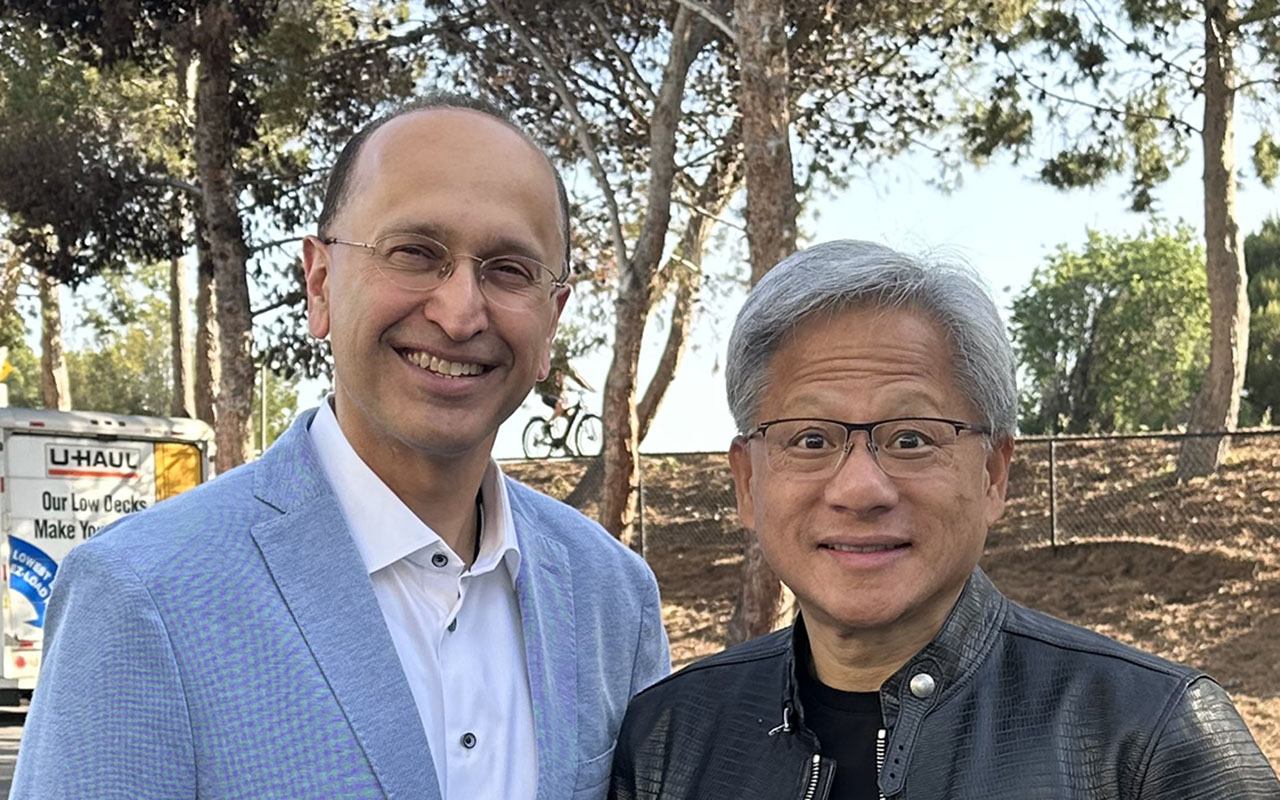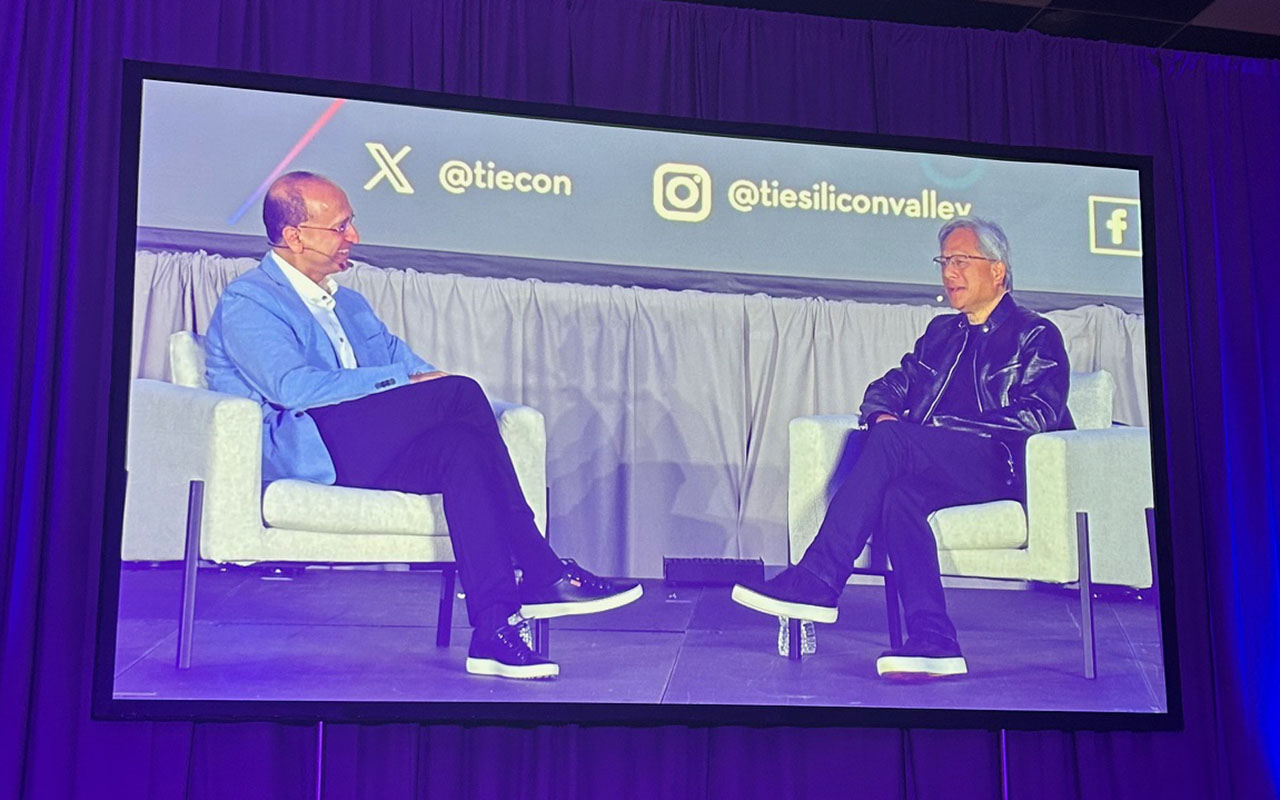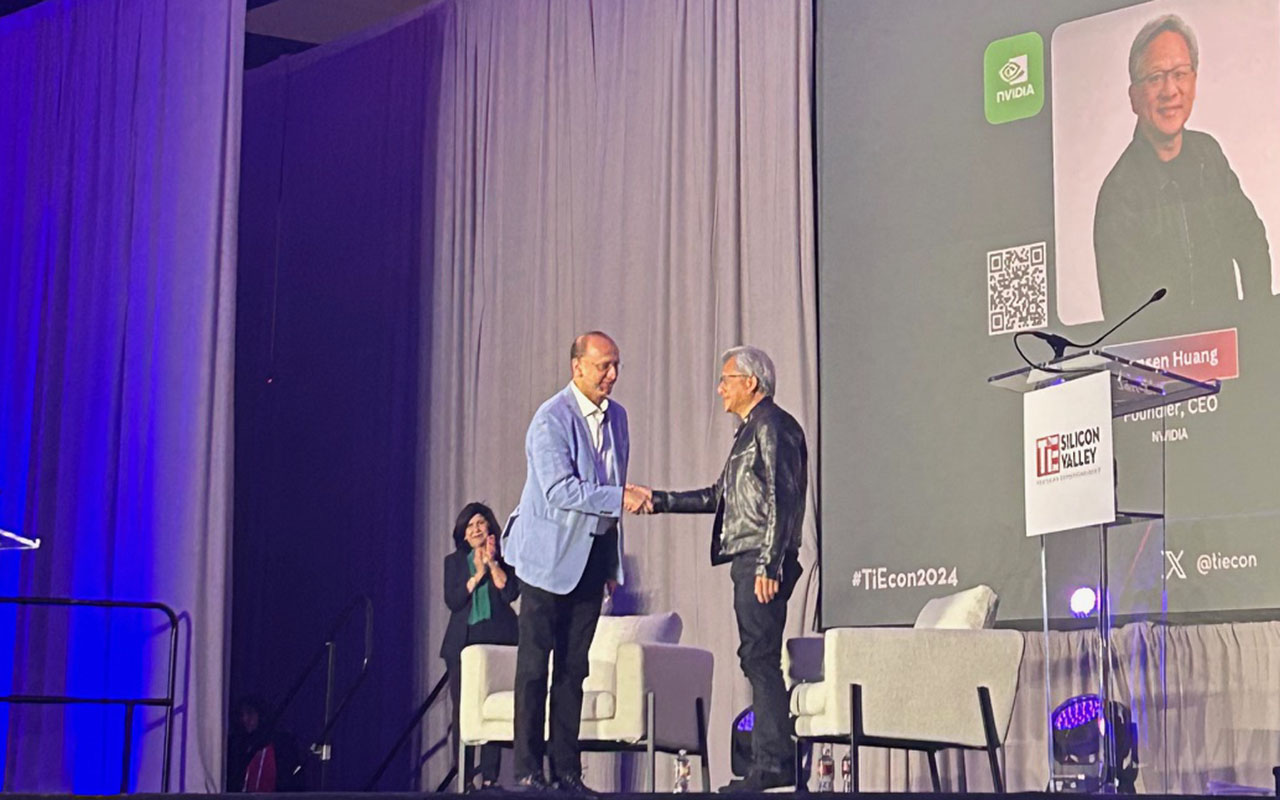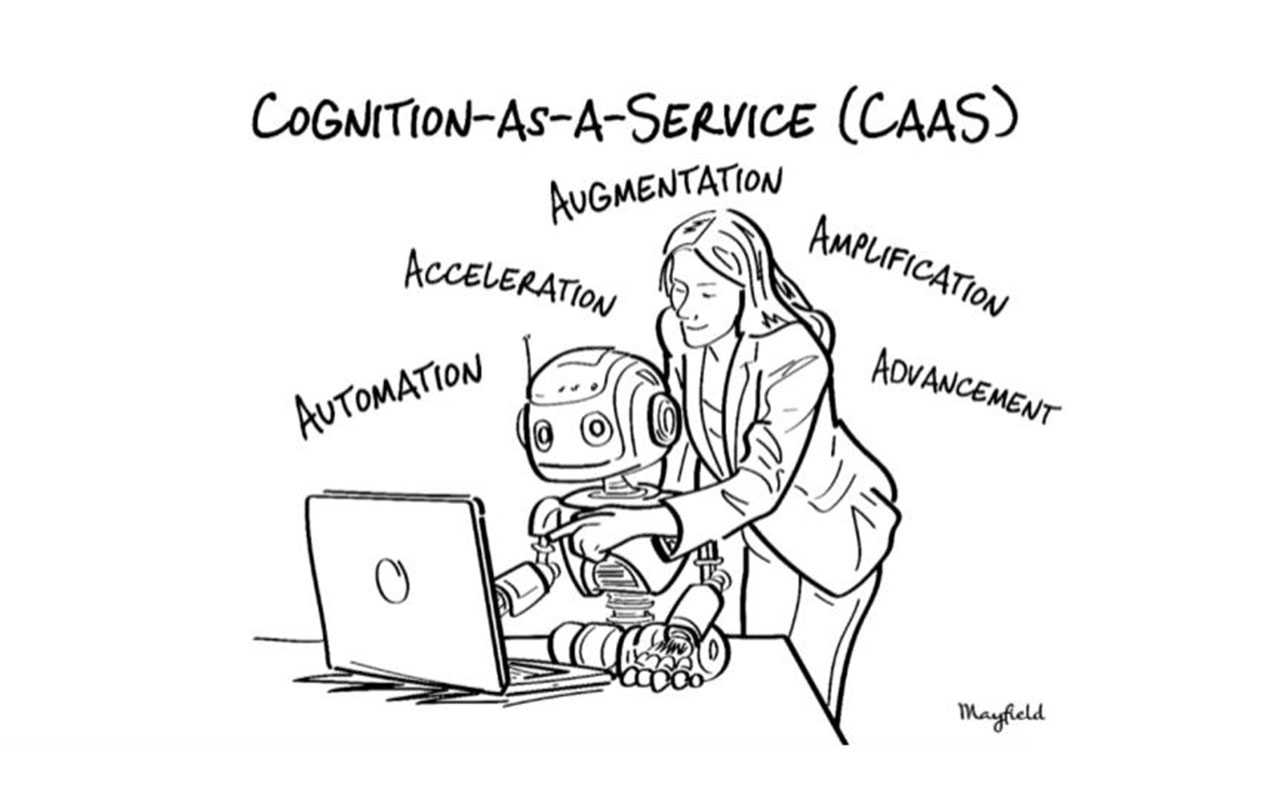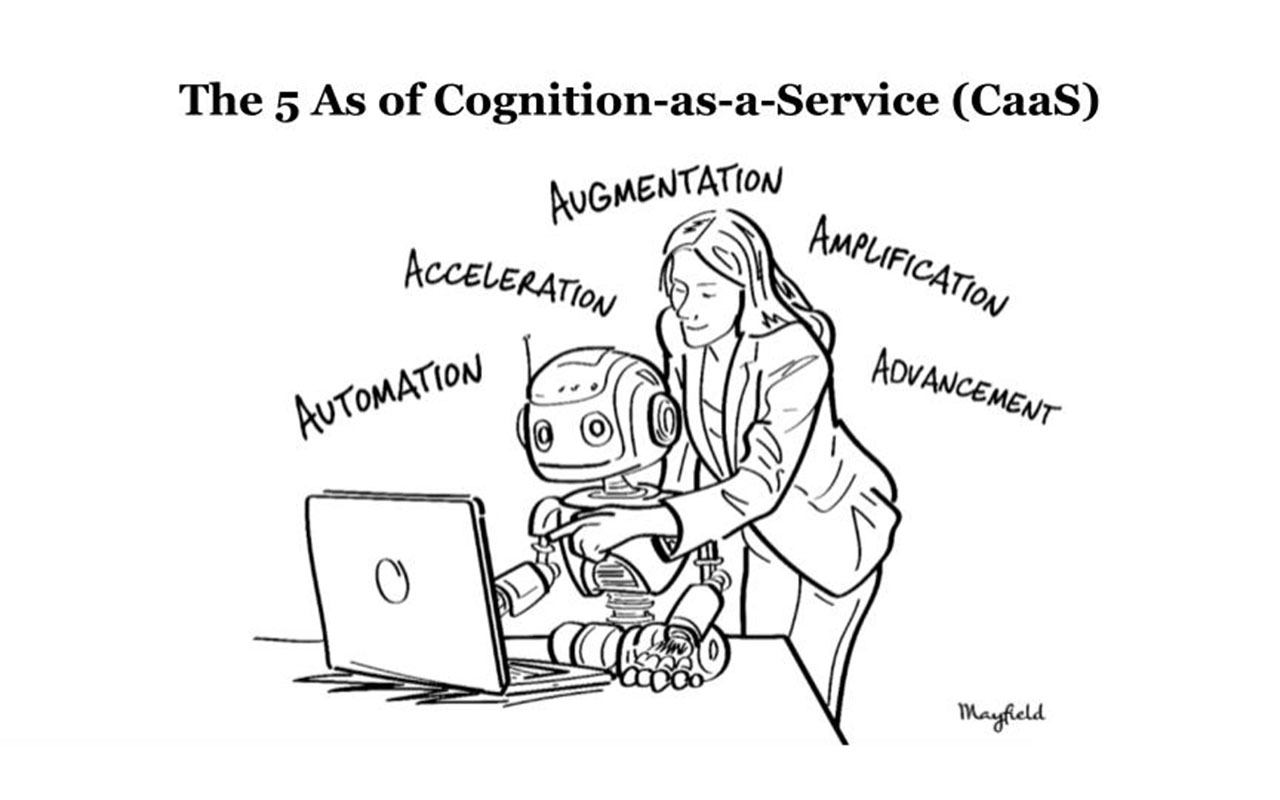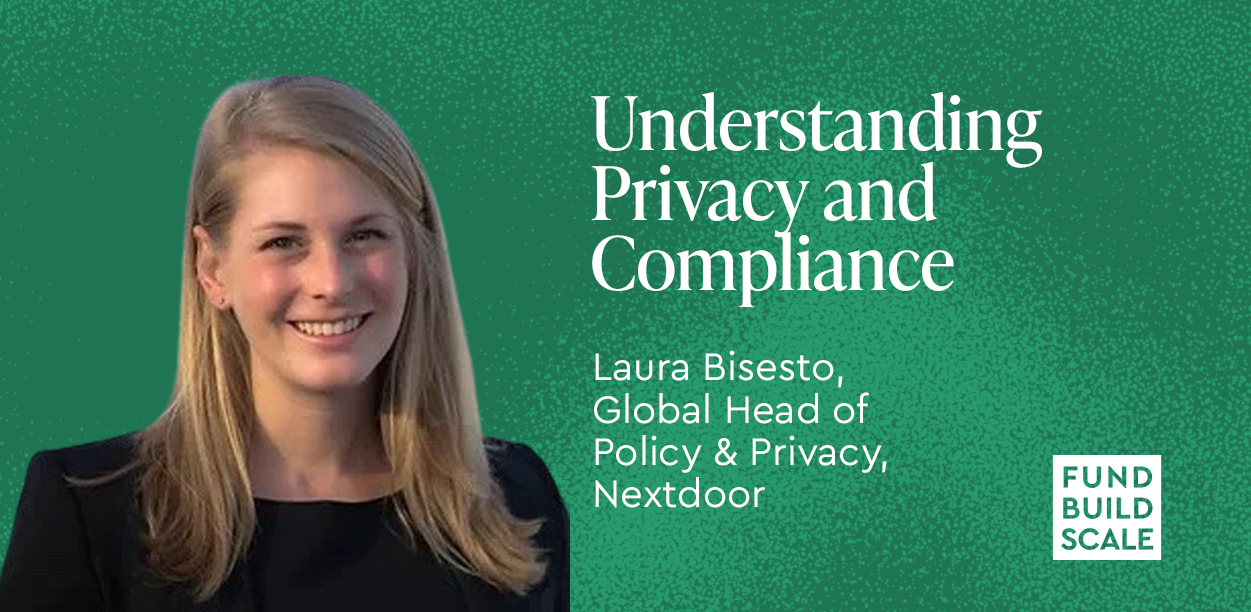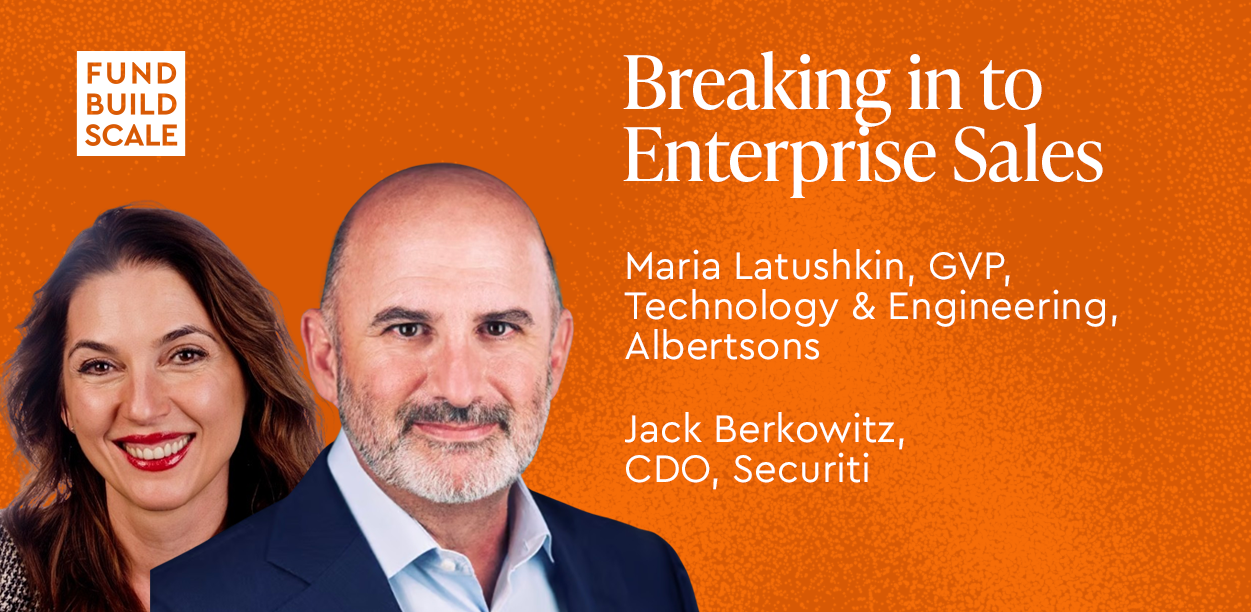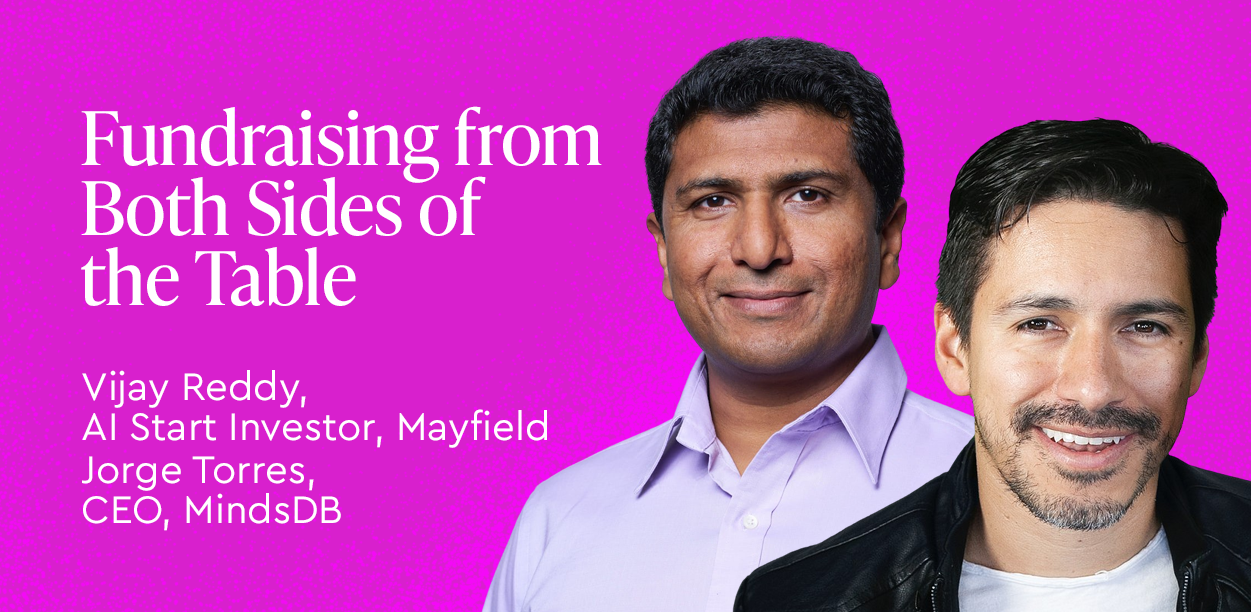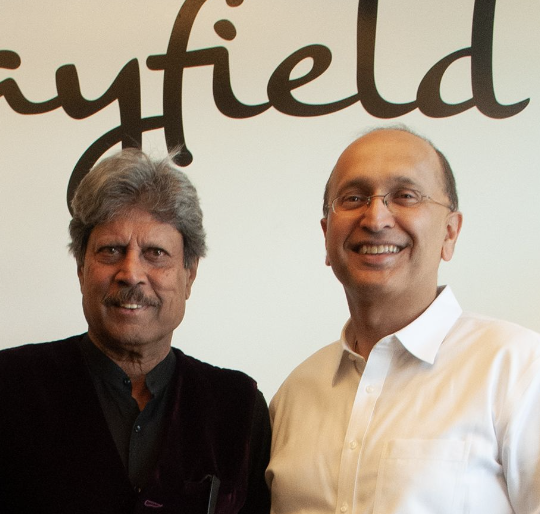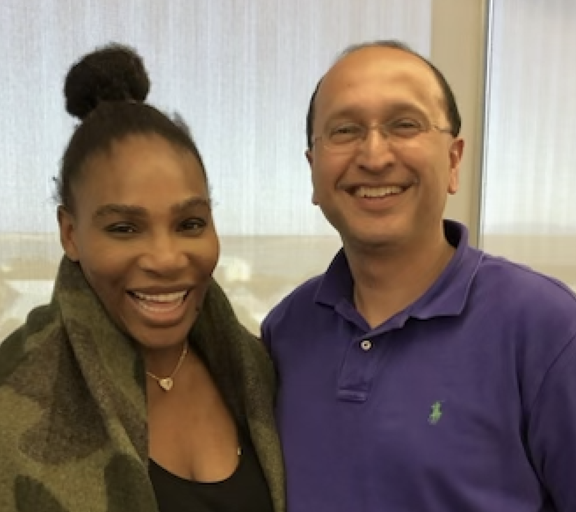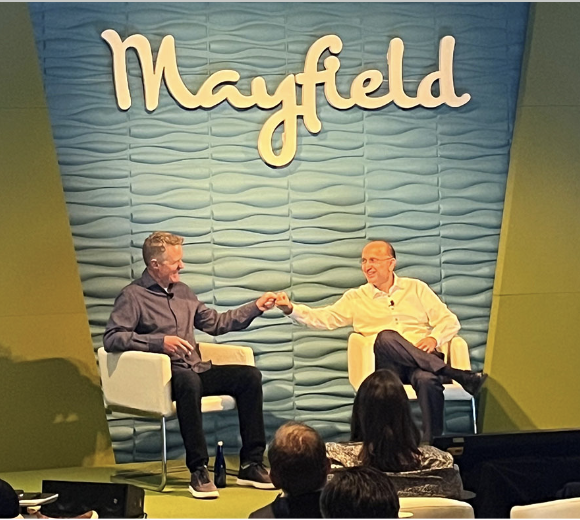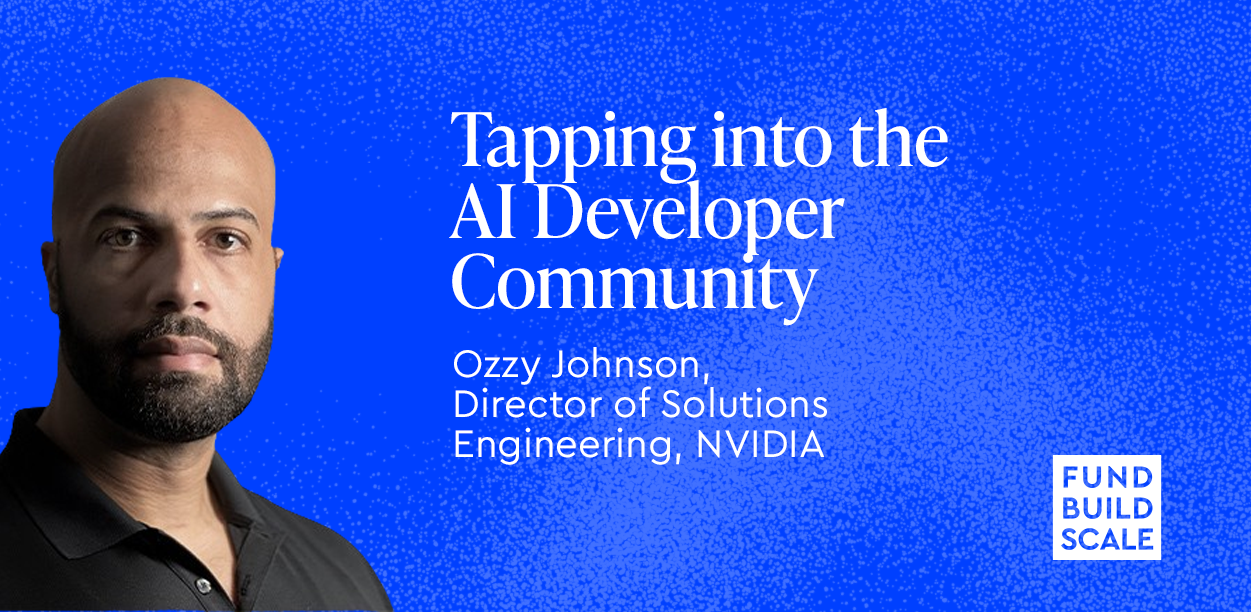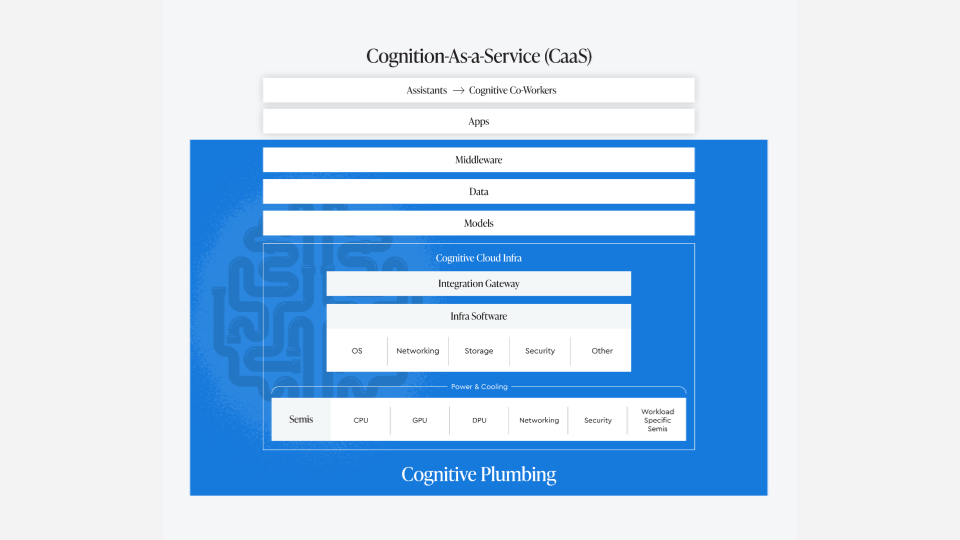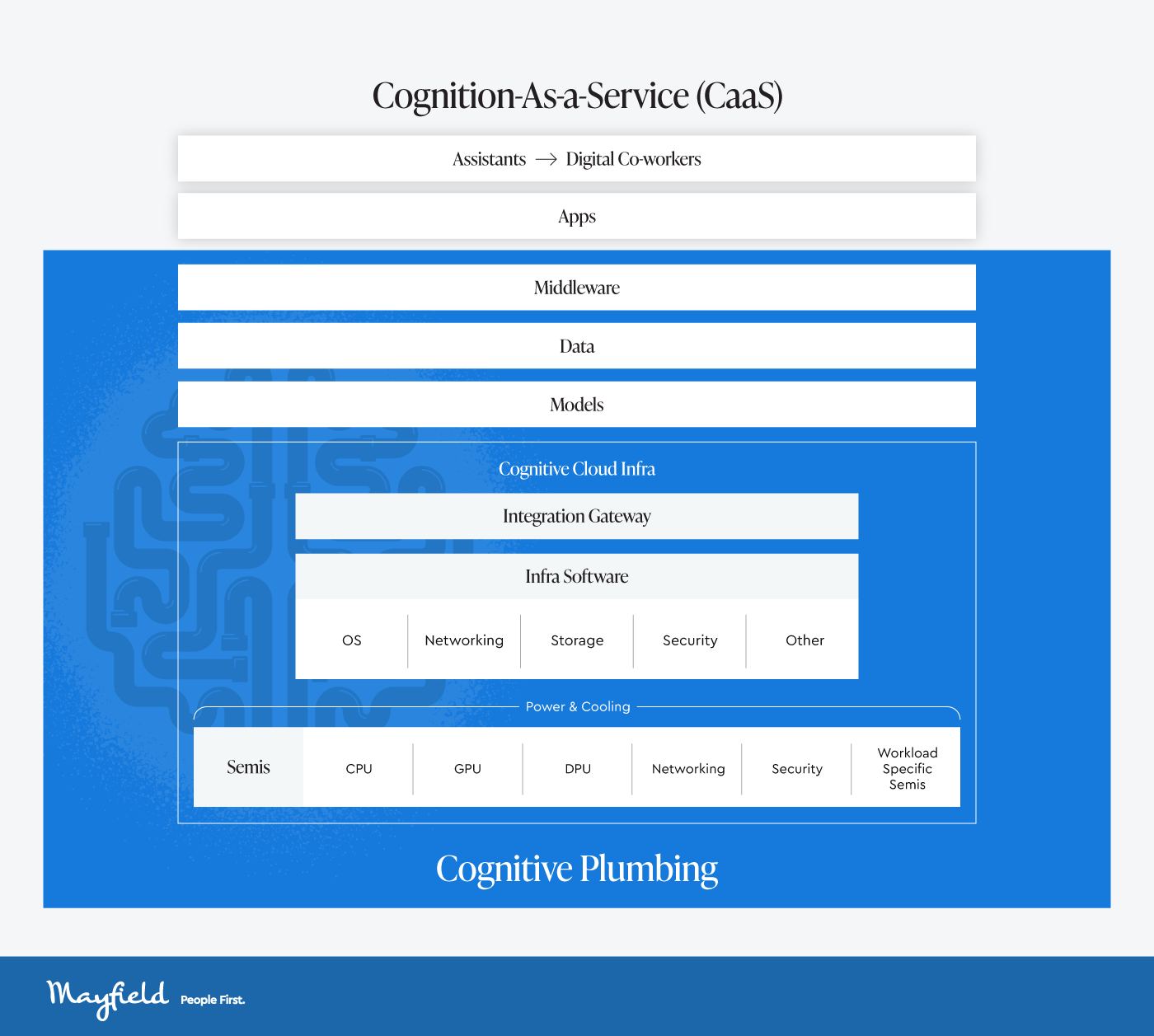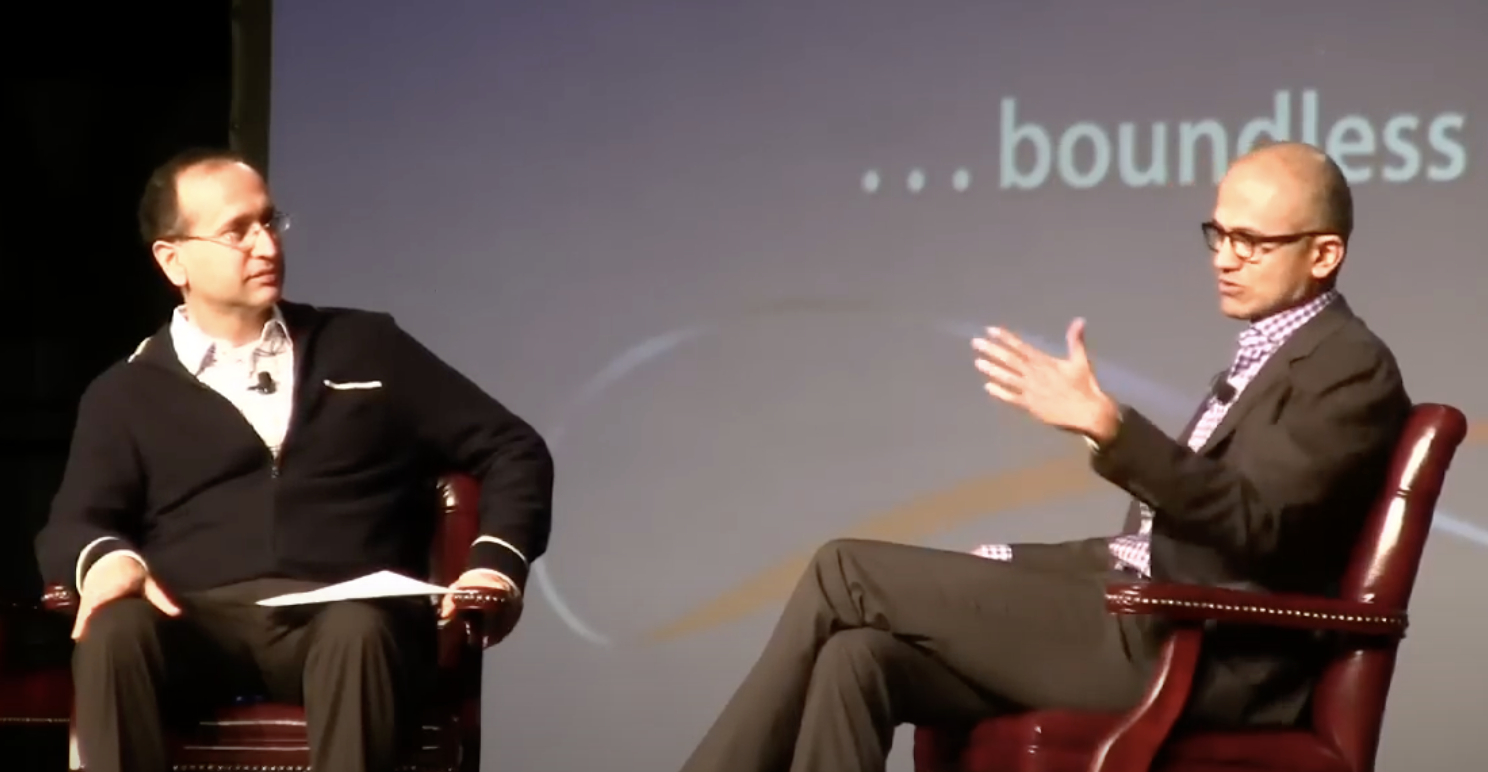Here is the transcript (edited for space and clarity) of the conversation between Fund/Build/Scale podcast host Walter Thompson; May Habib, CEO of Writer, and Gaurav Misra, CEO of Captions, on how they transformed their visions into something tangible enough for others to believe in.
May Habib 00:02
There has definitely been a broadening of our vision as a result of really taking a platform capabilities approach and really democratizing access to how we ourselves build, you know, essentially generative AI and NLP apps.
Gaurav Misra 00:21
A lot of it was us convincing ourselves that that was the right vision at first. But then once we were convinced, and we saw the data, and we really liked what we saw, then convincing investors, I think at the end of the day, it turned out to be way easier to convince the investors. The hard part was to convince yourself
Walter Thompson 00:42
That was May Habib, CEO of Writer, and Gaurav Misra, CEO of Captions. Writer is a full-stack generative AI platform for enterprise clients, and Captions offers digital creators a suite of AI-powered creative tools. These are radically new products and services, but before May and Gaurav could build their teams, establish trust with investors or land their first customers, they first had to transform the personal visions into something sturdy and tangible enough for others to believe in and attach to. I interviewed them individually to learn more about how they formulated their initial design and marketing strategies, and the frameworks they developed over time to keep refining their value propositions. We also talked about personal brand building, and the challenges that come with being a company’s chief storyteller. I’m Walter Thompson. This is Fund/Build/Scale.
Walter Thompson 01:33
I’m talking today with May Habib, who is CEO and co-founder of Writer. May, thanks very much for joining me today.
May Habib 02:00
Hi, Walter, thank you so much for having me.
Walter Thompson 02:03
Can you talk a little bit about the idea behind Writer. What initially sparked the notion for this company?
May Habib 02:10
Yeah, my co-founder and I were running a machine translation company. And we were doing localization mostly for technology companies, you know, trying to get their software, working in other languages as they expanded internationally. And, you know, the ideas that became Writer, I usually talk about us, you know, we discovered transformers and encoder decoders, and you know, that’s a really technological way I come at it. But the problem that was very interesting, as we delved into translation that was really exciting as well, there was this problem that we kept seeing over and over and over in source language quality. So the English that you were now trying to take in a Japanese, well, pretty disjointed across the entire user journey and kind of sounds different when marketing is writing about value props and brand, etc. And then pretty different when customer support is writing about the same things on a knowledge graph, knowledge base. And so for us the original kind of founding ideas of Writer were an AI writing assistant, that we would build transformers first. And so in terms of all the other rules-based AI writing assistants, this was going to be just a much more interesting product. And the initial wedge into an organization was content, quality and consistency. And so the first kind of slide deck for Writer after our market research etc., was, you know, an AI writing assistant that did AI writing over time, with this wedge into an organization of a brand and of kind of editorial consistency. And it’s super exploded since in the last four years, the product’s depth and breadth, this has widened a lot. And we call ourselves a full-stack generative AI platform. You can build apps on Writer as diverse as legal review to customer agent support. But those were some of the founding ideas.
Walter Thompson 04:28
This is four years ago, you’re talking about. So at that point, you know, things were very different as far as the AI landscape, the people you’re trying to bring on board. I’m guessing they were fairly knowledgeable about AI and machine learning. You had a deep bench of talent, or were these people who are coming in cold?
May Habib 04:42
Super-deep bench. I mean, these are folks who are building machine translation models right from scratch. So the encoder/decoder together combo was not something we’ve been doing for a couple years. That team in 2020, We did not add that many people in 2020, we added a head of linguistics, you know, who led NLP engineering and now heads up our customer engineers, everybody from those early months, has just had such a steep learning curve at the company, it’s been so, so beautiful and just such an honor to watch. But 2020, we didn’t add that many team members, we added our founding marketer, Christian at the end of that year, he’s still doing incredible things. We’ve, we’ve really only lost one person since those early days, actually. So the team is pretty, pretty together from early days, and folks have got a lot of a broadened scope and responsibility since then.
Walter Thompson 05:52
So those early employees, they were technically proficient, they didn’t require a lot of education to understand the value you were offering or plan to offer customers. But am I right? And suspecting it is a little different as far as investors — did investors grasp this automatically? How much investor education did you have to do to communicate your vision to investors?
May Habib 06:11
Yeah, in 2020, I do remember spending a lot of time on the AI behind the AI. You know, it’s like, “oh, you use AI. Okay, great. Yeah. Tell me about go-to-market again, you know, like, what about Grammarly?” Right. And so it wasn’t like it is now where you folks are really smart on so much of everything from training costs to inference to you know, ongoing kind of differentiation and modes, right, like kind of within, within the LLM space. It was all very nascent. In 2020, when you’re running, you know, raising our seed for sure.
Walter Thompson 06:51
A lot of the founders I’ve spoken to so far, they all continued to refine their value prop over time as they iterated their way into the market. Was that your experience as well? And how much did your initial vision change over time?
May Habib 07:03
Oh, it’s changed. It’s changed a lot. I think we’ve been pretty consistent since the A since it’s, since we kind of said, look, the transition of the first vision of Writer is the last unstructured business process. Writer’s about great writing for everyone, to now really being a full-stack generative AI platform where our vision is to transform work, there has definitely been a broadening of our vision as a result of really taking a platform capabilities approach and really democratizing access to how we ourselves build, you know, essentially generative AI and NLP apps. There’s so many applications, and we said, you know, we’re not going to be able to think of them all. So better, we expose some of these building blocks. And then the solutions are at 90% of the way there kind of buy vertical. And customers get to customize them a ton.
Walter Thompson 08:05
It sounds like you’re saying this wasn’t a hard sell, when you’re going out and you’re fundraising, investors got this and you didn’t have to do a long roadshow of a lot of heartbreak. A lot of people were open to this idea.
May Habib 08:17
Yeah, the A was quick, the B was even quicker.
Walter Thompson 08:20
So, how quickly did you recognize the investors who shared or supported your vision? And can you share an example of when you realized you’ve made one of those connections? Hmm,
May Habib 08:30
That’s a great question. With Insight [Partners] they had done — this is Devin and Ryan, hi, folks, if you’re listening — they had done Turnitin together and Turnitin had been a competitor to Grammarly. And, you know, they sold it for billions. And it had done well. But, you know, they’re sitting on the board and really felt like there was just a lot more in this market in the AI writing space. And so, when I met them, just very quickly, within the first five minutes, they were asking questions about technology that nobody else was asking. And they really understood why our product and our approach and our hook into the enterprise customer was so different than what they had seen before. And so they were really intrigued, because it was just, you know, they just had so much context. And so they really stood out. And it was very clear, they were going to be the best partner for the business. And then with Iconiq, they had been so good since the EA, have really just been in a very humble way, right? Helping get educated on the business. And sometimes like, investors will see you raise a round and then someone sort of I’m going to put air quotes around this, you know, build a relationship for the next round and it’s like, do you Yeah, I know you’re f***ing getting information for your CRM, I hear you typing. Right. And that wasn’t them at all. And I did not make that mistake with the second company. I don’t do those meetings. But they came to the office, they introduced us to potential customers, potential hires, those were all just really awesome. And then\ in our first meeting, they walked us through their thesis and why they were excited about Writer and you know, folks they had talked to, it was just already like, it felt like they had been part of the company for a few months. It was, you know, that it just stood out. In that group of folks that we talked to, for the B, it was head and shoulders above everybody else, honestly. When
Walter Thompson 10:45
Basically it sounds like, looking back, what was the hardest part of communicating your vision to others early on? And, a follow up, when did it become easier, and how did you turn that corner? Who helped you?
May Habib 10:59
In the B — I think there was, and it’s funny that this was just the summer, holy s**t, right? It was six months ago, seven months ago. It’s amazing how fast the market is moving in general today, I would say, when we started talking to investors, like mid- or late July, for the B the, the questions were about Microsoft and hyperscaler competition. “And wait, why do you also have an application layer? Like, what’s that about? Are you infrastructure, are you app layer?” And I think the most sophisticated folks have gotten wise pretty quickly, especially if they’re close to enterprise customers, really understanding how it wants to buy this now. And the AI infrastructure, go to market, and the weaknesses of that revenue being enduring and growing with so much competition, I think the benefit of the full-stack approach, I think, is really becoming pretty obvious for people who are spending time with with enterprise customers like a lot of the best, you know, enterprise software investors are. I would think that the next round, that’ll look pretty different. It already feels different from the kind of inbound that we get. But that was a lot of the kind of competitive conversation at the B was around hyperscalers. And the ongoing defensible moat.
Walter Thompson 12:44
I think there’s always a strong expectation that somebody on the founding team has, if not strong storytelling skills to some storytelling skills at all. Do you think of yourself as a natural storyteller? And how have you become more comfortable doing it? If you’re not? If you don’t see yourself?
May Habib 13:00
You know, Walter, no one’s asked me that question. I don’t see myself as a storyteller, I see myself as decent at picking up signal from noise. And explaining that to people, I see people who really have great storytelling abilities, and I know, I don’t have that. I gotta have something to explain for you to remember what I said. Whereas, I think folks who are really good at storytelling make you feel a certain way. I know, I don’t have that. I probably should find time to practice it, I’m the CEO of a company. And so I should have that. But given how dynamic this space is, and how new it is that it’s rare that something is competitive, and dynamic, and new, all at once, it’s been very helpful to have the ability to explain things. And we frequently get the feedback from both technical and non-technical people. It’s not just me, it’s the top 20 people at the company, “I listened when you talk, like, I know what you’re saying, when you speak to me about this stuff. And I don’t see that or hear that when your competitors come to talk to me.” And that is really gratifying. And I do think it comes from our founding team’s ability to try to just get to the root of something. And just that really being kind of all there is, not really a lot of artifice around it.
Walter Thompson 14:33
Again, looking back this and this is again, the conversation mostly kind of focuses on the early days of kind of struggling to translate vision into reality. Did you have any writing or design experience before this as far as helping you present this to an audience? Which tools or platforms did you use if you didn’t have a skill set for design, for example?
May Habib 14:49
You know, what’s funny in our Series A so many folks were like, “whoa, that was a killer presentation. How did you do that?” And Um, it was the presentation, I actually put together myself. But the visuals our brilliant brand designer had done in Figma. And it was both you know, Pete Hodge, a brilliant creative director and videographer Andy Orsow was amazing, he’s at Frame now, we worked with him on contract while he was between Invision and Frame, and we really tried to get to the idea of what it would look like and feel like if all writing at a company was systemized and that really came through in the visuals. You know, for, for the B, we just had so much data right on go-to-market and crazy NRR and just off the charts growth and great customer stories. And so from a visual perspective, the B and A decks looked really, really different. But I do care a lot about design,about brand. Our creative director is a genius, and it’s literally all him. And I think it helps to have founders who really care that if the slide doesn’t look great, I will ask for help. And now we’ve got, you know, another brand designer working with him, Nastia. So, you know, it’s always been a very visual company from a product perspective, you know, we get tons of props from folks on the UX of our chat interfaces, like in the digital assistant interfaces, as well as the the custom AI apps interfaces, the setup. So we’ve made generative AI UX really simple, even in an enterprise setting where you’ve got thousands of users to configure. And so it just has to make its way to marketing. And yeah, I love our site, the team does an amazing job. And you know, the investor decks, I just feel like it’s my responsibility to make sure they really reflect the quality that is in the product, and as in the marketing,
Walter Thompson 17:19
When did you bring in outside help? Was it Series A or seed stage, as far as helping you do the visual presentation?
May Habib 17:25
It’s always been mostly in-house — on the video side, we’ve always used external resources for video. And it hasn’t really been our intention, but every, like 10 to 12 months, we have a company video. So we’re on our third iteration. I love it. It’s on our homepage right now, check it out. Andy helped us with that, too, plus a second person, Jamie, has also been amazing. But we’ve never had an in-house video person, we probably should. It’s not a P0 this quarter. But I imagine it will be next. But on just like the pitch deck, it’s always been internal. And the content for the decks is its own workstream. And for the B, you know, it was a lot of work, because it is the work of really distilling down the data into a story that ties to your future and also really, you know, takes a candid look at the past, that’s not easy. And so I think it really helped that we did the deck in the data room really in the same sprint, Walter. So it actually started with the data, it was kind of iterative, so sort of like a rough outline of what we want to say. And then how would that be supported in the data room? Well, what’s the double-click? What’s the double-double-click? How are we going to gate the process as well? So I sort of did like the under the trnt first meeting. So if I had a lot of trust with somebody, they kind of got one deck in the first meeting, if I was just meeting somebody, they got a slightly different deck in the first meeting. And then what would different kind of gates look like, what would it unlock in the data room? And so that really that kind of iteration with then “oh, what do we put in the slide? What questions are we going to answer in the deck versus you know, where are we going to send people for more data in the data room?” So that was about a three-week sprint that I did with our head of go-to-market ops and my chief of staff, and honestly they did most of the work after some of my initial thoughts.
Walter Thompson 19:45
The AI landscape has shifted considerably since you raised your initial seed and series A, so how have you adapted your communication strategy or marketing strategy, whatever you want to call it, to to compensate?
May Habib 19:58
Great question. I have got I’m straight to the people, Walter! And I would say, probably, even till the Series A, I think I looked down on people who were active on LinkedIn. I don’t know, it just was like, it just felt like, I don’t know what it felt like —
Walter Thompson 20:18
I have some experience here? I don’t want to, I don’t want to shut you off. From my perspective, but I, but I haven’t liked about LinkedIn is this whole concept is that everyone’s a thought leader. Thought leadership is great, but to me, it’s meant to make the speaker look good. It’s not meant to create a lot of value for the person receiving it. How do you feel about that?
May Habib 20:40
Yeah, maybe? Maybe that’s maybe that is it? I think that’s it. I think with generative AI, it really was different, because I felt like I had something to contribute. You know, I didn’t feel like I was doing it. Because it would help sales, or —
Walter Thompson 21:01
— performatively make yourself look good or establish your credentials —
May Habib 21:06
I really felt like, almost like an obligation to share. And, you know, there were things that folks had said, Oh, even investors, you know, share your journey, blah, blah, blah, perseverance, blah, blah, blah, you know, that never also felt natural. And I actually, you know, now I’m very active on LinkedIn posts multiple times a week, 25,000 followers, I love LinkedIn. And I love the community there, and the people I’ve met there. And I would say, none of it has been about the journey every once in a while the leader posts about our team, you know, but I’m just not comfortable talking about, you know, the sausage making. The learning, though, is so, so important, it’s mutual, I’ll post a hot take, because I kind of also want to see who comes out of the woodwork on it and the number of awesome customer conversations and prospective customer conversations I’ve had as a result of just posting what we’re learning, you know, on on the enterprise generative AI journey, it just been great. So I guess my shift on communication strategy has really been, don’t be afraid to go out of your comfort zone, but also, you’ve got to be authentic and right. And LinkedIn just didn’t feel right for me until I really felt like I had a unique point of view, to share that people truly couldn’t get anywhere else, you know, otherwise, it just felt like, you know, wasting people’s time.
Walter Thompson 22:42
As hot as AI is, I’ve heard that a lot of startups are meeting strong headwinds when they’re trying to sell to into the enterprise, not because they’re anti-AI, but just because they don’t have a lot of internal expertise to evaluate what’s good or what’s bad, or what’s hype? Is that something you’ve seen, have you encountered this issue? And if so, how did you work around it?
May Habib 23:01
I think enterprises are getting fatigued. And so, you know, startups always had an uphill battle in the enterprise. And now you’re trying to pitch something that AWS and Azure and Google are in there pitching, OpenAI, plus another 50 startups supposed to the CEO and the board is in their inbox plus there is like the 800 gsi, that’s in there for attention to it’s a lot. And the security risks here are really real for the enterprise. And even for enterprise grade platforms, where the whole thing can sit inside of somebody’s cloud, right? The months of work you have to go through after the org wants the thing. It’s real. And it’s not for everybody. And you got to really love enterprise users, and enterprise problems, and working deep on transformation with people to I think, love this. You also have to love going to Vegas, a lot of enterprise stuff happened in Vegas. That’s weird. I’ve been there twice this year. I literally had not been in a decade. That was a half-joke, but you know, it’s just a very different motion. So I don’t know that it’s necessarily an AI problem. It’s a problem that AI risks make really stark that there is just the level of heft, breadth, depth. We’re hiring a CISO, because it’s not just about having the right answers on that security questionnaire. It’s about really having folks on your team that have the same kinds of experiences of these enterprise folks. Right to really be able to reflect kind of confidence right in, in your posture. And so, you know, it’s not for everybody, we love it, we’ve embraced it. We love our enterprise customers.
Walter Thompson 25:19
First half of my last question, could you share a few words of advice for somebody who’s getting ready to fund and launch an AI startup in 2024? How can they communicate their vision in a way that makes them stand out in a very free crowded field? Hmm.
May Habib 25:35
What’s really cool about this space is just how tangible and hands-on the advances of AI capabilities are and the product, the storytelling is so vivid. Today, we were on-site at a customer, a CPG company [with] globally recognized multiple brands. And they’ve got, they’ve got this problem, where the legal review of ads takes literally weeks and weeks and weeks. And so we built an app in real time on the Writer platform in their office, where they uploaded an ad. And it told them whether the dog was too overweight for the laws of that country. Those are actual laws. And it was just — they were blown away, like ‘holy crap,’ right. And that’s what you can do with a full-stack generative AI platform. If you are launching a company, show, don’t tell if it’s AI. Show, don’t tell it, because the capabilities are so wild, you can really blow people away showing them.
Walter Thompson 26:50
That’s amazing. Here’s my last question for you. If you were interviewing at a seed-stage AI startup, you’re across the desk, you’re looking for a job, they’re thinking about hiring you, what are some of the questions or concerns you’d want to have settled before you could say yes.
May Habib 27:07
I don’t know if I put myself in that position. But if I were really young, and were interviewing at a seed-stage AI startup, you’re in it to learn, right? I wouldn’t ask about funding. Well maybe runway, you want to make sure you have a learning trajectory for 18 months, at least. But I would ask, depending on if it’s a non-technical role, I would ask about the customers, “who’s gonna be using this? Who am I going to be talking to every day? Who is this for?” And then if it was a technical role,”what part do I get to work on? And I do think the getting alums to cool, do cool stuff, part of the tech stack has just not been it’s not a solved problem, right. And there’s a lot of innovation in how you connect LLMs to data structured and unstructured, a lot of innovation in how you steer LLM outputs. And so, you know, I think there’s just much more interesting stuff to be doing than training models. That is really hard work. And there’s a ton of innovation there too. But, you know, I think I’d want to be closer to the application layer. And so, you know, depending on the company, what they were doing, those would be some of the things I’d be asking you about.
Walter Thompson 28:40
Excellent. May. Thanks again for a fantastic conversation. I really appreciate it.
May Habib
Great talking to you, Walter.
Part 2
Walter Thompson
I’m talking with Gaurav Misra today. He’s the CEO and co-founder of Captions. Hi, Gaurav, thanks for joining us.
Gaurav Misra 30:18
Of course, happy to be here.
Walter Thompson 30:19
Let’s start with the basics. How did you and your co-founder come together?
Gaurav Misra 30:25
Totally. So, you know, my co-founder and I have known each other for a long time. And that’s not a very common thing with startups, usually, I think people often meet their co-founders, you know, you know, while they’re coming up with their idea, or the thing about starting a company, but in my case, my co-founder, and I met about 10 years ago, 10 years before we started the company, at a totally other startup. And, you know, we only overlapped there for about three months, but we really kept in touch and got along. And we both always sort of had this idea of, hey, we’re gonna start a company one day, and we would discuss it, we would meet up every couple of months, you know, we even move cities in the middle of that at some point, and still would connect with each other. And that connection really stuck with me. And then when I actually came around to hey, I’m actually ready to start a company now. You know, he’s the first person that came to mind. And since we’d been in touch for so long, it just seemed like the right person to work with.
Walter Thompson 31:18
Can you talk briefly about how your skill sets complement each other? Why does this work for you?
Gaurav Misra 31:23
I think that complementary skill sets are very important. As a founder of a company, you kind of have to have a generalized skill set anyways, very likely, you’ll have to do almost everything in the beginning, maybe you’re an engineer, but you’ll still have to do sales or marketing, or, you know, maybe you’re recruiting, so you kind of have to have that generalized skill set. So it really comes down to at the end, what does your co-founder want to do out of all the things that the company needs to do? And what do you want to do? Because there’s only the two of you, or the three of you at the beginning, right? So everything that needs to be done needs to be divided in some way. So with us, you know, it actually evolved quite a bit, we both have a pretty generalized background, you know, my co-founder, Dwight also has an engineering background, he also has a product background, and he’s done a bit of marketing, a bit of everything, right? I enjoy all of the same things as well. So we’ve kind of shifted over time, done a little bit of this, a little bit of that, and see where we excel, right, do more of that. You know, as the company has grown, obviously, we’ve hired people to do a lot of these things. And, you know, people are way better than we are. But in the beginning, we kind of mixed it up a little bit and tried a bunch of different things.
Walter Thompson 32:36
So when you and Dwight sat down and started formulating ideas for the company, did you start with a vision statement that was kind of an aspirational thing that described what you wanted to achieve? Or was there a mission statement that kind of described what you wanted to accomplish and how you got there? What was your early process?
Gaurav Misra 32:52
What we were interested in was social media, actually, in the beginning, the reason being that it was evolving heavily in terms of you know, how people communicate on social media, whether, you know, previously, it was more maybe text or photos, and now it was more videos dominating the landscape, right? Or whether it was some other scenario, like maybe AI is playing a bigger role in it, right. And so we were excited about that space evolving. And we knew that there was something there that we could solve something we could do. So that’s kind of how we initially picked it as an area, we want to come up with a lot of different ideas in this space and see what gets us excited and what where we can find product market fit.
Walter Thompson 33:38
Okay, so for your first employee, how did you initially articulate your vision?
Gaurav Misra 33:42
The interesting thing at that point is we were a little bit open-minded about the vision ourselves. And I think that’s something that is important to do at the early stage, is not to get too locked into one idea or one angle that you want to take. Because the evolution is so fast at the earliest stage you should almost assume that you will be changing ideas very quickly, evolving and moving. Because if you don’t, then it’s definitely going to be very hard to work out. And very rarely is the first idea, the right idea. The way we thought about it is like, “this is the area we’re interested in, we’re gonna go explore, we’re gonna go talk to customers, see what people are doing, see what the trends are today. And then we’re gonna try to build a bunch of different things. See, what has legs, what do people actually want? What do people come back and use again, and that’ll help us guide right, like, what’s the direction? What’s the flow? Where’s the river actually flowing?” Just to get our bearings and figure out what direction we should be going in. So when we hired our first employees, including Cam, I was just talking about, you know, we were kind of pitching them this idea of we’re going to experiment, right, we’re going to experiment this is the area so as long If you’re interested in, you know, some of these fundamentals, we’re gonna go and experiment, find what’s interesting. And I think that’s really important to set the expectation. Because, you know, the last thing you want is people getting discouraged when you have to change direction, especially in the early days, right? You want people to get excited about changing direction, let’s try something new. Let’s build a whole new thing. It’ll be fun, right? And so that should be almost the expectation from the beginning.
Walter Thompson 35:26
You were talking to early customers, which I mean, everyone does as part of the customer discovery process. But Captions is really a product for social media users. Who are those customers you identified that you wanted to talk to and understand their problems and their challenges?
Gaurav Misra 35:42
We were looking at a lot of college students and sort of people who were trying to get into YouTube, trying to make a YouTube channel trying to, you know, maybe get into TikTok, and, you know, become a TikTok creator, we weren’t going in and talking to people who were established in terms of someone who has a ton of followers or something like that, but really people trying to break into the area, and what are the challenges they’re facing, though, initially when we started the company, our goal was to be a social media platform ourselves. And our thought was hey, maybe we’ll build a creation tool to get people creating on our platform, and that’ll be a way to start off potentially a social media platform. But eventually, obviously, we realized that we were way more excited just about the creation and the opportunity there. So that’s kind of the evolution of the company. But we went out and talked to a lot of people to help solve that creation, you know, problem that we were trying to go after,
Walter Thompson 36:39
Were you talking to investors with the intention of being a social media platform? Or was that something that you did after? When did that even happen?
Gaurav Misra 36:46
We definitely talked to investors about being a social media platform. That was the initial sort of approach, and the initial way we pitch to investors was like, “hey, we’re gonna make a creation tool,” and actually, Captions existed at that point, like it was, you know, the earliest version of it, something we had put together in two days, basically. But we took that and we went to investors, and we were like, “hey, this is the beginning, you know, this is how we’ll attract our first creators on the platform. Right. But once we have a critical mass of creators, we’re gonna convert this into a social media platform.” So that was the original pitch.
Walter Thompson 37:23
Jumping back, around how much time did you spend doing market research and customer discovery, after you settled on the newer direction for just kind of being a toolbox?
Gaurav Misra 37:35
A lot. So I think this is like counter to probably the advice most people will give, because a lot of people think of user discovery and sort of like talking to customers, especially in a consumer space that we’re in as, not as interesting, or sometimes people think that it’s not as useful, because how are you going to find these people? How many people are going to actually talk to you, right, given there’s billions of people in the world, but actually, some of the social media platforms themselves like TikTok. And, you know, nowadays, there’s Reels and YouTube Shorts, they actually ended up being a really good way to see what is popular to understand what the trends are, and to understand what people are doing right day to day. And I think it’s a really good way to actually even test startup ideas, even if they have nothing to do with, you know, social media specifically, but if they’re consumer ideas, to put, you know, a pitch out there on Tik Tok or another platform and see if it resonates with people, people will comment, right, though, it’ll come on their feet, and they’ll be like, “this is a bad idea. I don’t like it.” Or maybe they’d be like, “oh, I love this, this, if only this existed.” And that initial validation, I think, is very important. And sometimes, if you really get it, right, and if you really hit it, right, it can just go viral right there, right. And you can just get a ton of feedback instantly on what people might be interested in. Maybe you’ve hit something, something really cool, right? So I actually think it’s a great idea to put the idea out there on social media platforms, or even see what the trends are. Currently, what are people doing, you know, there’s a niche for everything on social media is finding those niches and discovering what our existing users are doing. It’s a great way to do that. Without having to think about, “how am I going to find these people to talk to?”
Walter Thompson 39:25
Were the investors you spoke to, were they supportive and on board for the change in strategy and in focus? They believed enough in the toolset that they weren’t scared off by, “let’s not be a platform, let’s just be tools for helping creators, that was okay?”
Gaurav Misra 39:41
Yeah, there was definitely a sort of a transformation period there in the company, right? We were a very small company at that time, just a couple of employees, for the first year or so. A lot of it was us convincing ourselves that that was the right vision at first, but then once we were convinced, and we saw the data, and we really liked what we saw, then going and convincing investors. But I think at the end of the day, it turned out to be way easier to convince the investors. The hard part was convincing yourself.
Walter Thompson 40:16
It makes sense. The investors I talked to are way more open, they expect the iterative process, they expect pivots, and they’re not spinning, they’re not thrown by it as much as I might be. Or you would be, I suppose, because it’s not their baby.
Gaurav Misra 40:36
For me, it might feel existential, like “oh, my god, we’re changing the whole direction, is this good or bad?” And it’s something that you really want to get right for your own sake, for the employees’ sake, for the investors’ sake, everybody’s sort of trusting you to build something interesting, right. And so it’s definitely a lot of pressure. But I think, at the end of the day, you just have to kind of come back to that original idea that change is expected. And especially with the initials teams that have this idea that we will be iterating, we will be evolving. If we’re not doing five different ideas, then we’re not doing something right.
Walter Thompson 41:15
Founders build relationships with investors over time. So how quickly did you recognize the investors who you could work with? And was it harder? Was it easy to recognize ones who just didn’t get it, or were you were just like, “I didn’t want to take your money. I can’t work with you.”
Gaurav Misra 41:29
Yep. At the earliest stage, especially at the seed stage, or pre-seed stage, or anything in that area, I think it’s really important to have an investor who understands the space inside and out. So, if you’re working on let’s say, camera technology, then you should have an investor who understands what goes into building camera technology, right? And the reason I say that is because there are going to be ups and downs in doing that. And if the investor doesn’t have an understanding of why those ups and downs are okay, or not, okay? Or then they might become more of a burden on you, because they’ll just keep asking you questions about are things going okay, or not going? And they may not have the ability to actually make a call on their own, looking at the data to say, “yes, things are going fine. And we just need to do these two or three things to actually, you know, go make this something bigger.” Or they might look at even look at something that potentially has success and be, “yeah, that’s cool, but not at the [moment], maybe that’s not interesting, they may not be able to see something that does work, right for what it is. So I think that alignment, the beginning is really important, which is why we went and looked for investors who really understood the space. And for us, that was social media at that time. We’re still in the social media space in many ways. So that hasn’t fundamentally changed. We’re just building a different product and that space, so the university has turned out to be the right investors for that.
Walter Thompson 42:57
From your perspective, if you’re doing a lot of investor education, does that mean you’re basically talking to the wrong people?
Gaurav Misra 43:01
I think it’s tough. In that case, I would say it’s wrong every time. And it’s not something we’ve had to deal with too much. But I’ve heard from other people that it can be, you know, a time sink. And usually, at the later stages, it’s something you know, it’s harder tofind people who just get what you’re doing. Anyways. So I think it’s a tough ask to say everybody should get exactly what we’re doing, right? Sometimes people bring different values and or have different expertise that you might need in your company. So I think that statement probably evolves over time. But I think at the earliest stage, you probably really want someone who really gets it, who you get along with, because it’s a long journey. I mean, to give you an example, on our first investor, you know, Matt has met with us every two weeks, right from the beginning, right, without, with no breaks, and has listened to the worst of what we’ve done the best of what we’ve done, given us advice at every point, not judge, you know, positive or negative on how we’ve been operating, but given us the right tools to be able to do the right things for the company.
Walter Thompson 44:12
Looking back, what’s been the hardest part about communicating your vision to other people?
Gaurav Misra 44:17
I think the hardest part has been, — I would say it’s not been like articulating it or putting it in the right format, or, you know, putting it on a PowerPoint or you know, whatever. I think that stuff always gets figured out. But the hardest part has been what do we actually want to do, and what did we see actually working? Because if you have investors that can understand the space, then oftentimes, if you’re not convinced yourselves, and you’re not exactly convinced that you really believe in this direction or you want to do this, then investors can see through that a lot of times, especially the ones that are well educated in this space. So I think the number one step is figuring out yourself, what is it that you want to do, and what do you see actually working? And then putting that into a format that other people can understand is probably secondary,
Walter Thompson 45:14
Was it just totally kind of a self taught process? Did you rope in people to advise you? How did that work?
Gaurav Misra 45:22
A lot of it was, I think self-taught, you kind of have to figure out your own way of doing it in terms of people doing it for the first time, I would think of it you know, the startup world is actually not too different than how a big company might operate, like a very large company. Soif someone is starting a company who has worked at a very large company in the past, like an Amazon or a Google or something of that sort, it’s actually very similar, right? Someone has an idea, they have to go to someone very senior to pitch this idea and say, “hey, we need these resources to actually make this.” This person might decide, “you know, what, I don’t like the idea. So it’s not going to happen.” Or maybe they’re like, “you know what, I love it, you’ll get two people, and a year of time to go do this.” And then you do it. And maybe it works really well. And you go back and the next OKR meeting, and you show them, “oh my god, I achieved all these things. We could use five more people, and we could do these other things.”. And so it’s actually very similar. And that’s your Series A or something, right? So I would think of it the same way, I wouldn’t get too intimidated by the process, or the people or the investors. Everybody’s just people, I think everybody’s just trying to do something interesting and cool in their life. You just have to come to the table with that attitude and show people what you’re excited about and what you want to do, and how you can see it working in a similar way as you might do within a company itself.
Walter Thompson 46:44
I think with a lot of early-stage founders, there’s a lot of — maybe this is my perspective as a journalist, it seems like there’s a strong expectation that somebody on the founding team has strong storytelling skills. Do you think of yourself as a natural storyteller?
Gaurav Misra 47:00
I don’t think of myself as a natural storyteller. I think it’s something that I had to learn a little bit more of, I do think it’s an important skill, because at the end of the day, you know, the numbers will tell the story of your company to a certain extent, like, “hey, things are going in this direction.” But there is a larger vision. And that’s the whole point of venture capital in some way. Itt’s not just about what is happening now, but the vision that’s possible years down the line of what could be achieved. And a lot of the time, it’s very transformational. It’s something that is world-changing in some way, Or it could be that big, and the ability to tell that to people, win people over, is kind of fundamental, not just from the fundraising perspective, but from the employee’s perspective. They want to be inspired, and they want to be able to see what could be right. And I mean, for every side, almost for anybody you talk to, as a founder, you kind of have to sell the story. And this idea, this vision. And not everyone’s gonna buy it. That’s for sure. But you have to convince the right people basically.
Walter Thompson 48:11
Weird question, but do you have any experience as a writer? What was your storytelling experience before this? What was the most storytelling you did? Do you have any kind of creative writing experience, or what’s your background before this as far as weaving a narrative?
Gaurav Misra 48:29
I started sort of picking up a little bit more of that for my career. As I mentioned before, it kind of becomes important internally in companies to to an extent, because companies internally operate very similarly. You have to sell what your team is doing. And make sure people are convinced that what you’re doing is important. Those are skills that probably everybody should work on, and everybody should build over time as a career grows. Besides that, I switched from engineering to product design, in my career. So sort of the visual storytelling aspect, I learned a lot at my previous company where I used to work, which was Snapchat, and I got a chance to work, you know, on the design team there and see their world class design team, how they operate. And the team works very closely with their founder, who’s also a great storyteller. So you know, seeing that in action, and seeing how that happens day in and day out, was a huge learning experience for me.
Walter Thompson 49:35
Are you still kind of Captions’ chief storyteller, or have you handed that role off to somebody else?
Gaurav Misra 49:42
Most of the time, I’m the one doing that. So I think it’s important because I think it’s one of the most critical pieces of what drives the vision and the direction of the company. And I think it’s something that the founders should always have a hand in?
Walter Thompson 50:01
Can you talk about how you kind of attach your vision for the company to your go-to-market strategy? As far as the value proposition you were presenting to people, what was it? And how has it changed since you went into the market?
Gaurav Misra 50:16
One of the interesting things that we’ve all often faced and many companies often face is some sort of disconnect — there’s the vision, but we’re going to mark it in a totally different way. And I think in those cases, you have to be kind of honest with yourself and be like, “something doesn’t seem right.” And often, when something doesn’t seem right, something isn’t right. And you have to either evolve your vision a little bit, or evolve your strategy a little bit. And when you do that, everything feels right. Like, “wait, we actually solve something.” But it does require a bunch of thought. And I think for us it’s shifted over time, both in terms of vision, we’re constantly evolving it and aligning it to what is most current and what will work best in today’s environment. But also on the strategy of how we actually sell the product is evolving exactly with that vision. And as long as we can keep those two things lined up side by side, it seems like we can keep product-market-fit going and expanding. I think when those two things kind of go in different directions, then things start to go wrong a little bit. And you’re doing something and saying something else. That’s the beginning of all problems, I think.
Walter Thompson 51:28
Noted. So the landscape has shifted considerably since you’ve initially raised. Have you adapted your communication strategy since then, or your vision strategy since then with an eye towards raising future funds?
Gaurav Misra 51:42
It’s always evolving. Three years ago was a much easier time to raise money for many people, it was just a different environment. That’s obviously shifted over the last three years, especially with interest rates and all that, just the general macroeconomic situation. Not to say that that’s the most important thing for raising funds. As the company grows, the vision does become more and more crystal clear of what you’re trying to do. A lot of the things that were ambiguous or things that need to be figured out, or things that were a little bit nebulous in the early days, you’ve found answers to those questions by now, you know what works and what doesn’t work. And actually, you have a very simple and strategic idea that works at this point. Hopefully. Now, the problem is now almost in reverse, like, what should you reveal, because at this point, the core of what you have works. And if you say too much, other people might be interested in jumping on that, as well: “Oh, so that’s how it works. I get it, let me do that, too.” Whether that’s a big company, or whether that’s another startup, or whatever that might be. You have to be a little bit more careful about how you articulate your vision at this point, and to what detail you go into, revealing all the learnings that you’ve built over the last three years. You’ve spent a lot of time building a ton of learnings about what works and what doesn’t work? And what is the vision actually, what part of the vision is the core vision?
Walter Thompson 53:22
It seems like the people you’re talking to, they’re eager to adopt new AI products. So it’s not an issue for you?
Gaurav Misra 53:28
Definitely, from what we’ve seen, and we do get a lot of outreach from enterprise customers as well, in terms of integrating our technology into their workflows. And we’re not prioritizing that at the moment. But it does seem like there is an appetite for it. But I think there’s a very specific thing that people should think about when building, certainly AI technologies. Currently, there’s a lot of hype, as everybody knows, and there’s nothing wrong with that, I think it’s a good thing. People are excited about a new technology. But with hype, what happens is a lot of technologies that are built that may not be useful in the long run, but are exciting and interesting in the short run. And those don’t tend to make great businesses at the end of the day. So I think what’s most important to watch for right now is whether people retain and use something over and over again. And in my opinion, the best way to tell that is by looking at what people are doing today. And then you provide an alternate solution, right? Maybe it’s powered by AI, right? And so once people try the alternate solution, they should never want to go back to the original, they should be like, “wow, my life has changed forever. This new thing is what I’m going to do, right, no matter how simple that thing is.” If you can switch people over from the original workflow to something new, and they stick to it, then you have something right. And I think that’s what we look for. I think that’s what you know, we’ll build the right but the best businesses I think in the long term.
Walter Thompson 54:54
Last few questions. Can you share a few words of advice for a team that’s appearing to fund and launch an AI startup in 2024?
Gaurav Misra 55:04
My take on it is that it’s always good to have a prototype at the beginning, right? Don’t start by just going and raising money, start by putting, pen to paper and just creating a first version of something. It doesn’t have to be the idea that’s going to be the company forever, but you want to at least create the first version of something that you can show investors and get them excited. Maybe you can even show it to people. And you’ll get a lot of feedback very quickly on whether people like it, whether it’s useful or not, and investors will give feedback as well. It helps quite a bit with even just showing investors that you have the ability to actually create at the end of the day and put something in people’s hands, which I think is the biggest blocker at the earliest stage, actually taking an idea and converting it into reality in any way, even if it’s not a great idea, that doesn’t matter. That’s what I think helped us the most in the beginning is creating actual prototypes and showing those to investors. So I think the same applies even today, it probably is evergreen, especially in the AI space where it’s very difficult to create some of these things. But the right people with the right mindset can definitely do it.
Walter Thompson 56:28
Final question, words of advice for somebody who’s working in tech already, let’s say they’re working in a FAANG company or a large startup, who’s interviewing about an AI startup. What kind of questions should they be asking during the interview process? What should their due diligence process look like?
Gaurav Misra 56:43
The number one factor that will determine the long term success of most of the AI startups that are there right now is retention at the end of the day. Are people going to come back and use this thing again and again? And if retention is there, then everything else can fall into place. So I would think most about that. But at the end of the day, you know, regardless of the retention question, I think it’s a good time, in general, for people to switch into the AI space. It’s not, you know, it’s not one of those things that’s a small change that will kind of be there and then be gone. It does feel like a more fundamental change, especially for more technical people. Whether it’s an engineer, or maybe a designer, where there’s a whole new skill set to learn. There’s a whole new space that’s expanding, that’s very different from traditionally how engineering has been done. And the earlier you can get into it, there’s a lot of value in it. It may not be the one company today that you join, right, but the skills that you’ll learn there actually will be very applicable in many, many, many, many companies in the future, I believe. But I think for the success of the company, retention is probably the number-one factor.
Walter Thompson 58:04
Gaurav, thanks very much for a great conversation. I really appreciate the time.
Gaurav Misra 58:07
Thank you. It’s been awesome.
Walter Thompson 58:11
I’ll be right back with some show notes.
Thanks again to Gaurav Misra and May Habib for joining me on the podcast. Coming up next, I interviewed Rehan Jalil, President and CEO of Securiti, about basic best practices founders need to get a startup to a million dollars in annual recurring revenue, and beyond. A serial founder who’s now in his third company, Rehan reflected on his own journey to share what he’s learned about connecting with early customers product development, conducting ecosystem research and establishing an initial sales motion
Rehan Jalil 59:09
Yourself, and not just you, but as a team, you’re ready. If you’re ready, responsive, that’s where things change. You get ready, you establish strong relationships and strong trust with you and your customers.
Walter Thompson 59:23
If you’ve listened this far, I hope you got something out of the conversation. Subscribe to Fund/Build/Scale so you’ll automatically get future episodes, and consider leaving a review. Follow Fund/Build/Scale on LinkedIn and YouTube. For now, you can find the FBS newsletter on Substack. The show’s theme was written and performed by Michael Tritter and Carlos Chairez. Michael also edited the podcast and provided additional music. Thanks for listening.
